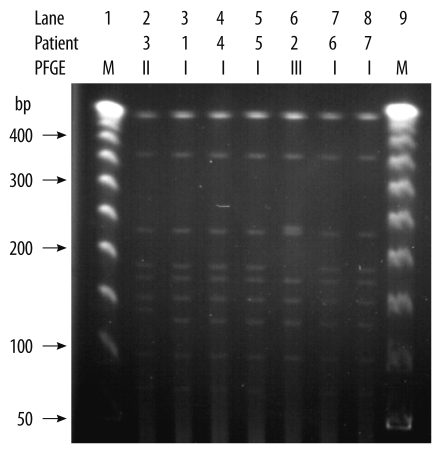Korean J Lab Med.
2011 Jul;31(3):191-196. 10.3343/kjlm.2011.31.3.191.
Emergence of Clostridium difficile Ribotype 027 in Korea
- Affiliations
-
- 1Department of Laboratory Medicine and Research Institute of Bacterial Resistance, Yonsei University College of Medicine, Seoul, Korea. leekcp@yuhs.ac
- 2Department of Laboratory Medicine, Konkuk University School of Medicine, Seoul, Korea.
- 3Department of Laboratory Medicine, Korea University College of Medicine, Seoul, Korea.
- KMID: 1735853
- DOI: http://doi.org/10.3343/kjlm.2011.31.3.191
Abstract
- BACKGROUND
Clostridium difficile infection (CDI) has markedly risen and is associated with hypervirulent ribotype 027 outbreaks in North America and Europe since 2003. The aims of this study were to determine the prevalence of ribotype 027 among C. difficile isolates in Korea, to characterize the ribotype 027 isolates, and to determine the clinical severity of CDI in patients infected with these isolates.
METHODS
A total of 1,251 isolates of C. difficile recovered from stool specimens of suspected CDI patients at two tertiary-care hospitals and one commercial laboratory between 2002 and 2009. Genes for toxin A (tcdA), toxin B (tcdB), and binary toxin (cdtA and cdtB) were detected by PCR. Mutation in the tcdC gene was detected by sequencing after PCR amplification. For molecular genotyping, we performed PCR-ribotyping, pulsed-field gel electrophoresis (PFGE), and multilocus variable-number tandem-repeat analysis (MLVA). Minimum inhibitory concentrations of moxifloxacin were determined using Etest strips (AB bioMerieux, Sweden).
RESULTS
We identified 7 isolates as ribotype 027. These isolates had the same tcdC mutation as the epidemic strain, and 6 of them were resistant to moxifloxacin. The isolates were categorized into 3 different PFGE types and 7 different MLVA types. All the 7 cases had occurred sporadically.
CONCLUSIONS
C. difficile ribotype 027 is uncommon, but it has emerged in Korea. The spread of this ribotype should be closely monitored in order to avoid an outbreak of CDI in Korea.
Keyword
MeSH Terms
-
Adult
Aged
Aged, 80 and over
Bacterial Proteins/genetics/metabolism
Bacterial Toxins/genetics/metabolism
Clostridium difficile/genetics/*isolation & purification
Drug Resistance, Bacterial
Electrophoresis, Gel, Pulsed-Field
Enterocolitis, Pseudomembranous/microbiology
Enterotoxins/genetics/metabolism
Feces/microbiology
Female
Humans
Male
Microbial Sensitivity Tests
Middle Aged
Mutation
Polymerase Chain Reaction
Republic of Korea
*Ribotyping
Figure
Reference
-
1. Warny M, Pepin J, Fang A, Killgore G, Thompson A, Brazier J, et al. Toxin production by an emerging strain of Clostridium difficile associated with outbreaks of severe disease in North America and Europe. Lancet. 2005; 366:1079–1084. PMID: 16182895.2. Cheng VC, Yam WC, Chan JF, To KK, Ho PL, Yuen KY. Clostridium difficile ribotype 027 arrives in Hong Kong. Int J Antimicrob Agents. 2009; 34:492–493. PMID: 19464857.3. Kato H, Ito Y, van den Berg RJ, Kuijper EJ, Arakawa Y. First isolation of Clostridium difficile 027 in Japan. Euro Surveill. 2007; 12:E070111.3. PMID: 17370932.4. Tae CH, Jung SA, Song HJ, Kim SE, Choi HJ, Lee M, et al. The first case of antibiotic-associated colitis by Clostridium difficile PCR ribotype 027 in Korea. J Korean Med Sci. 2009; 24:520–524. PMID: 19543521.5. McDonald LC, Killgore GE, Thompson A, Owens RC Jr, Kazakova SV, Sambol SP, et al. An epidemic, toxin gene-variant strain of Clostridium difficile. N Engl J Med. 2005; 353:2433–2441. PMID: 16322603.6. Zar FA, Bakkanagari SR, Moorthi KM, Davis MB. A comparison of vancomycin and metronidazole for the treatment of Clostridium difficile-associated diarrhea, stratified by disease severity. Clin Infect Dis. 2007; 45:302–307. PMID: 17599306.7. Terhes G, Urbán E, Sóki J, Hamid KA, Nagy E. Community-acqu-ired Clostridium difficile diarrhea caused by binary toxin, toxin A, and toxin B gene-positive isolates in Hungary. J Clin Microbiol. 2004; 42:4316–4318. PMID: 15365032.8. Spigaglia P, Mastrantonio P. Comparative analysis of Clostridium difficile clinical isolates belonging to different genetic lineages and time periods. J Med Microbiol. 2004; 53:1129–1136. PMID: 15496392.9. O'Neill GL, Ogunsola FT, Brazier JS, Duerden BI. Modification of a PCR ribotyping method for application as a routine typing scheme for Clostridium difficile. Anaerobe. 1996; 2:205–209.10. Alonso R, Martín A, Peláez T, Marín M, Rodríguez-Creixéms M, Bouza E. An improved protocol for pulsed-field gel electrophoresis typing of Clostridium difficile. J Med Microbiol. 2005; 54:155–157. PMID: 15673509.11. Kim SJ, Kim H, Seo Y, Yong D, Jeong SH, Chong Y, et al. Molecular characterization of toxin A-negative, toxin B-positive variant stra-ins of Clostridium difficile isolated in Korea. Diagn Microbiol Infect Dis. 2010; 67:198–201. PMID: 20338708.12. Marsh JW, O'Leary MM, Shutt KA, Pasculle AW, Johnson S, Gerding DN, et al. Multilocus variable-number tandem-repeat analysis for investigation of Clostridium difficile transmission in Hospitals. J Clin Microbiol. 2006; 44:2558–2566. PMID: 16825380.13. Morgan OW, Rodrigues B, Elston T, Verlander NQ, Brown DF, Brazier J, et al. Clinical severity of Clostridium difficile PCR ribotype 027: a case-case study. PLoS One. 2008; 3:e1812. PMID: 18350149.14. Pépin J, Valiquette L, Alary ME, Villemure P, Pelletier A, Forget K, et al. Clostridium difficile-associated diarrhea in a region of Quebec from 1991 to 2003: a changing pattern of disease severity. CMAJ. 2004; 171:466–472. PMID: 15337727.
- Full Text Links
- Actions
-
Cited
- CITED
-
- Close
- Share
- Similar articles
-
- The First Case of Antibiotic-associated Colitis by Clostridium difficile PCR Ribotype 027 in Korea
- Evaluation of the Xpert Clostridium difficile Assay for the Diagnosis of Clostridium difficile Infection
- Clinical and microbiological risk factors for severe Clostridioides difficile infections in Korea
- Clostridium difficile Infections in Children
- SDS-PAGE profiles of clostridium difficile isolated from patientsand hospital environments


